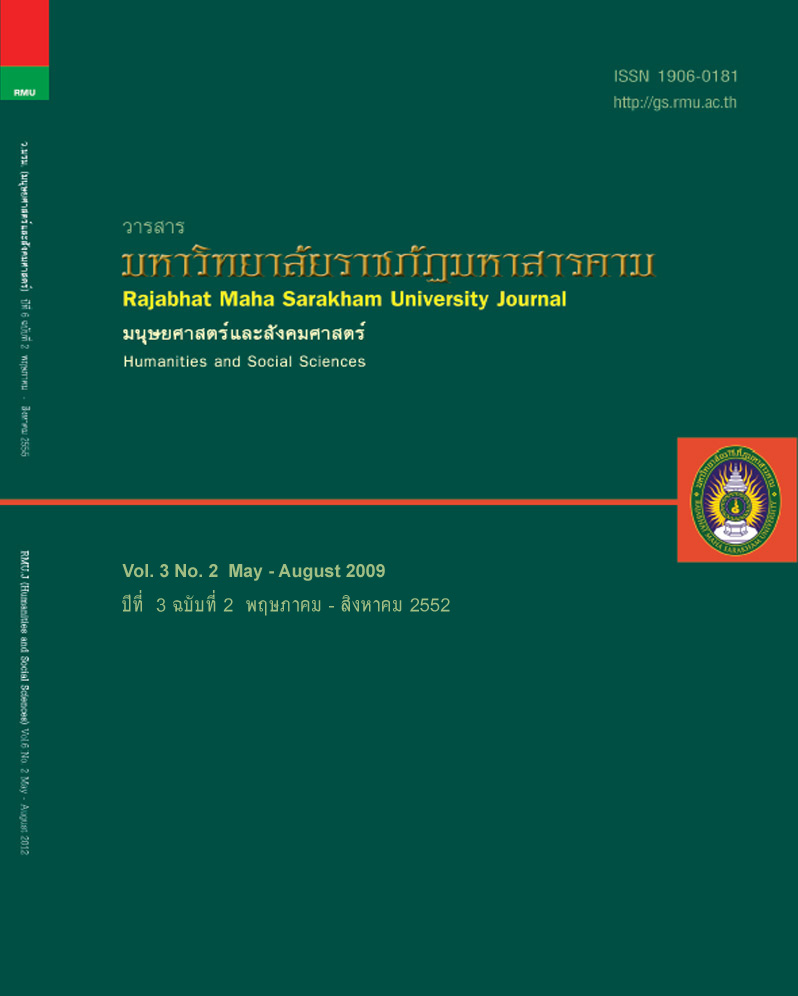การออกแบบและพัฒนาโมเดลสิ่งแวดล้อมการเรียนรู้บนเครือข่าย ตามแนวคอนสตรัคติวิสต์ที่ส่งเสริมการคิดสร้างสรรค์ของนักศึกษาระดับอุดมศึกษา Design and Development of Constructivist Web-Based Learning Environment Model To Enhance Creative Thinking for Higher Educati
Main Article Content
บทคัดย่อ
การศึกษาครั้งนี้มีวัตถุประสงค์ เพื่อออกแบบและพัฒนาโมเดลสิ่งแวดล้อมการเรียนรู้บนเครือข่ายตามแนวคอนสตรัคติวิสต์ที่ส่งเสริมการคิดสร้างสรรค์ของนักศึกษาระดับอุดมศึกษา กลุ่มเป้าหมายที่ใช้ในการวิจัยครั้งนี้ได้แก่ นักศึกษาสาขาคอมพิวเตอร์ศึกษา คณะศึกษาศาสตร์ มหาวิทยาลัยขอนแก่น ชั้นปีที่ 2 ภาคเรียนที่ 1 จำนวน 20 คน เป็นการวิจัยเชิงพัฒนา
ระยะที่ 1 ประกอบด้วย การวิจัยเอกสาร การวิจัยเชิงสำรวจ และการศึกษารายกรณี โดยมีขั้นตอนการดำเนินการวิจัย 5 ขั้น คือ
การศึกษาหลักการและทฤษฎี การศึกษาสภาพบริบท การสังเคราะห์กรอบแนวคิดการออกแบบโมเดลสิ่งแวดล้อมการเรียนรู้บนเครือข่าย การออกแบบและพัฒนาโมเดลสิ่งแวดล้อมการเรียนรู้บนเครือข่าย และการประเมินประสิทธิภาพของโมเดลสิ่งแวดล้อม
การเรียนรู้บนเครือข่าย การวิเคราะห์ข้อมูลเป็นการสรุปตีความโดยผู้วิจัย ผลการวิจัยพบว่า
โมเดลสิ่งแวดล้อมการเรียนรู้บนเครือข่ายตามแนวคอนสตรัคติวิสต์ที่ส่งเสริมการคิดสร้างสรรค์ของนักศึกษาระดับอุดมศึกษา มีองค์ประกอบที่สำคัญ ดังนี้คือ สถานการณ์ปัญหา แหล่งการเรียนรู้ กรณีใกล้เคียง เครื่องมือทางปัญญา ห้องปฏิบัติ
การการคิดสร้างสรรค์ การแลกเปลี่ยนเรียนรู้ ฐานการช่วยเหลือ และศูนย์ให้คำแนะนำ ประสิทธิภาพของโมเดล โดยโมเดลมีประสิทธิภาพตามการประเมินของผู้เชี่ยวชาญ ผลการเรียนของผู้เรียน ด้านการคิดสร้างสรรค์ และด้านผลสัมฤทธิ์ทางการเรียน
The purpose of this research was to design and develop the constructivist web-based learningenvironment model to enhance creative thinking for higher education students. The target group
consisted of 20 second year Bachelor’s degree students who were studying in computer education major,
Faculty of Education, Khonkaen University, in the first semester. The methodology of research anddevelopment was employed in this study. In phase 1 the activities included document analyses, surveysand case studies. The research procedure was carried out through 5 steps: a study of the principles and
theories; a study of the context; a synthesis of designing framework of the constructivist web-based
learning environment model; designing and development of a constructivist web-based learning environment model; and an evaluation of the efficiency of the constructivist web-based learning environment model. The data analysis employed an interpretation and conclusion by the researcher. The
results revealed that: The constructivist web-based learning environment model to enhance creative thinking for
higher education students comprised 8 important components: problematic situations; learning sources;related cases; mind tools; a creative thinking lab; collaboration; scaffolding; and coaching. In terms of efficiency, the model had the efficiency in the aspect of expert reviews, the aspect of learners’ opinions,
the aspect of creative thinking: and the aspect of learning achievement.
Article Details
1. บทความที่ลงตีพิมพ์ทุกเรื่องได้รับการตรวจทางวิชาการโดยผู้ประเมินอิสระ ผู้ทรงคุณวุฒิ (Peer Review) สาขาที่เกี่ยวข้อง อย่างน้อย 3 ท่าน ในรูปแบบ Double blind review
2. ข้อคิดเห็นใด ๆ ของบทความที่ลงตีพิมพ์ในวารสารมหาวิทยาลัยราชภัฏมหาสารคาม นี้เป็นของผู้เขียน คณะผู้จัดทำวารสารไม่จำเป็นต้องเห็นด้วย
3. กองบรรณาธิการวารสารมหาวิทยาลัยราชภัฏมหาสารคาม ไม่สงวนสิทธิ์การคัดลอกแต่ให้อ้างอิงแสดงที่มา


